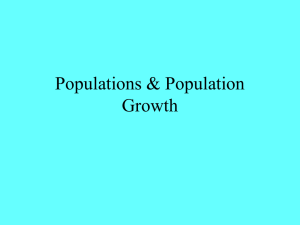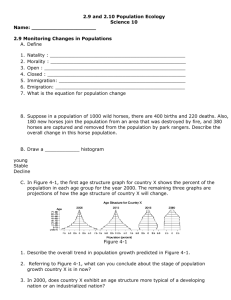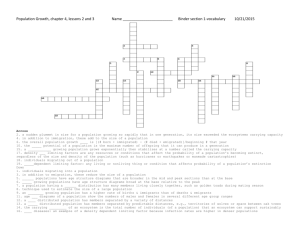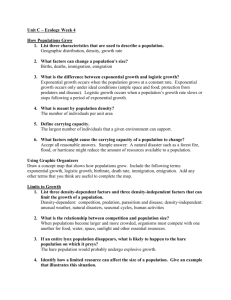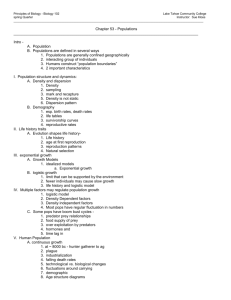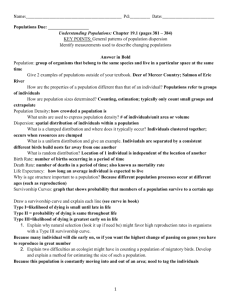BIO102-Ecology Part 1
advertisement
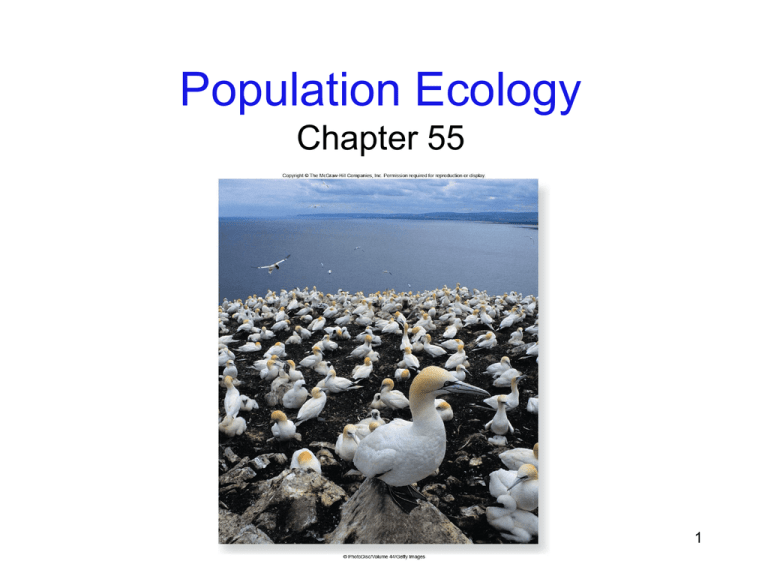
Population Ecology Chapter 55 1 Environmental Challenge • Ecology: the study of how organisms interact with one another and their environments. • Populations: groups of individuals of the same species in one place 2 Populations • Range: area throughout which a population occurs – Most species have limited geographic range • Devil’s hole pupfish lives in a single spring in southern Nevada 3 Populations • Humans alter the environment and some species have altered their range in reponse. Range expansion of the cattle egret 4 Populations • Dispersion: how individuals in a population are spread out within their range – Random: individuals do not interact strongly with one another. – Uniform: behavioral interactions, resource competition – Clumped: uneven distribution of resources. 5 6 Biotic Potential The rate of growth for a population if every individual survived and reproduced. • Under such ideal conditions, a population would have exponential growth Exponential growth = J-curve b=d Population Growth levels off as population approaches carrying capacity Exponential growth initially Lag phase Logistic Growth S-Curve Growth and Limits Many populations exhibit logistic growth 10 Carrying capacity (K): the maximum number of individuals in a species that an environment can support • Determined by the amount of resources available (food, water, nutrients, etc) • Results in logistic growth • Hunting brings pop to Winter K Demography and Dynamics • Demography: the quantitative study of populations – How size changes through time 12 Population Changes Calculating growth rates: (Births + I) - (Deaths + E) Immigrants (I) - Individuals moving into a population Emigrants (E) - Individuals moving out of a population (exiting) Limiting Factors: situations that prevent a population from increasing Density-Independent Factors --do not depend on the number of individuals in the population. --Usually abiotic factors such as pollution, weather events and natural disasters Density-Dependent Factors -become limiting only when population reaches a certain size -strongest when population is large and dense -usually biotic factors such as food, predators, disease, and competition Sawtooth Curve: Shows periodic fluctuations (rise and fall) of populations. --Can show density-dependant factors at work (predator-prey) --Can show density-independent factors at work (seasonal changes) Sawtooth Graph -showing seasonal population fluctuations summer winter Fluctuations in the number of pupae of four moth species in Germany 18 • North American snowshoe hare 10 year cycle • Two factors generate this cycle: – Food plants – Predators 19 Reproductive patterns 1.r-strategist: • produce many offspring in a short period of time (mice, flies) • take advantage of a temporarily abundant resource 2.k-strategist: • produce a few offspring that have a better chance of surviving with intense parental care (humans, elephants) • Limited resources, pop near carrying capacity 21 Human Population Growth • K-selected life history traits – Small brood size – Late reproduction – High degree of parental care • Human populations have grown exponentially – Last 300 years birth rate has remained same – Death rate has fallen dramatically 22 Human population growth: Year Estimated population (in millions) 0 A.D. 130 1650 500 1850 1,000 (1 billion) 1930 2,000 1970 4,000 (4 billion) 1998 6000 5/3/10 6,817,237,780 U.S. 309,191,081 A.The graph of human population is a J curve. It shows exponential growth Industrial Revolution begins Agriculture begins Plowing and irrigation Bubonic plague Number of years to add each billion (year) All of Human History First Billion Second Third Fourth 123 (1930) 33 (1960) 15 (1975) Fifth 12 (1987) Sixth 12 (1999) Seventh Eighth Ninth (1800) 13 (2012) 16 (2028) 26 (2054) Sources: First and second billion: Population Reference Bureau. Third through ninth billion: United Nations, World Population in 2300 (medium scenario), 2003. What has allowed human populations to grow exponentially? 1.)medicine 2.)plenty of food(agriculture) 3.) sanitation * medical advances allow people to live longer and decreases infant mortality (Child death) C.What is Earths’ carrying capacity? 1. Unknown 2. J curve will continue until some resource becomes limiting 3. Some countries have exceeded their carrying capacities: China, Ethiopia, Somalia, India 29 World Population Clock Natural Increase per Year Day Minute More Developed Countries World Less Developed Countries Less Developed Countries (less China) 80,224,198 219,792 912,053 2,499 79,312,145 217,294 71,498,784 195,887 153 2 151 136 Source: Population Reference Bureau, 2004 World Population Data Sheet. Human Population Growth Distribution of population growth 31 Human Population Growth • Consumption in the developed world further depletes resources – Wealthiest 20% of the world’s population accounts for 86% consumption of resources and produces 53% of CO2 emissions – Poorest countries: 20% is responsible for 1.3% consumption and 3% CO2 emissions 32 Human Population Growth Ecological Footprint: amount of productive land required to support an individual at the standard of living of a particular population through the course of his/her life 33

